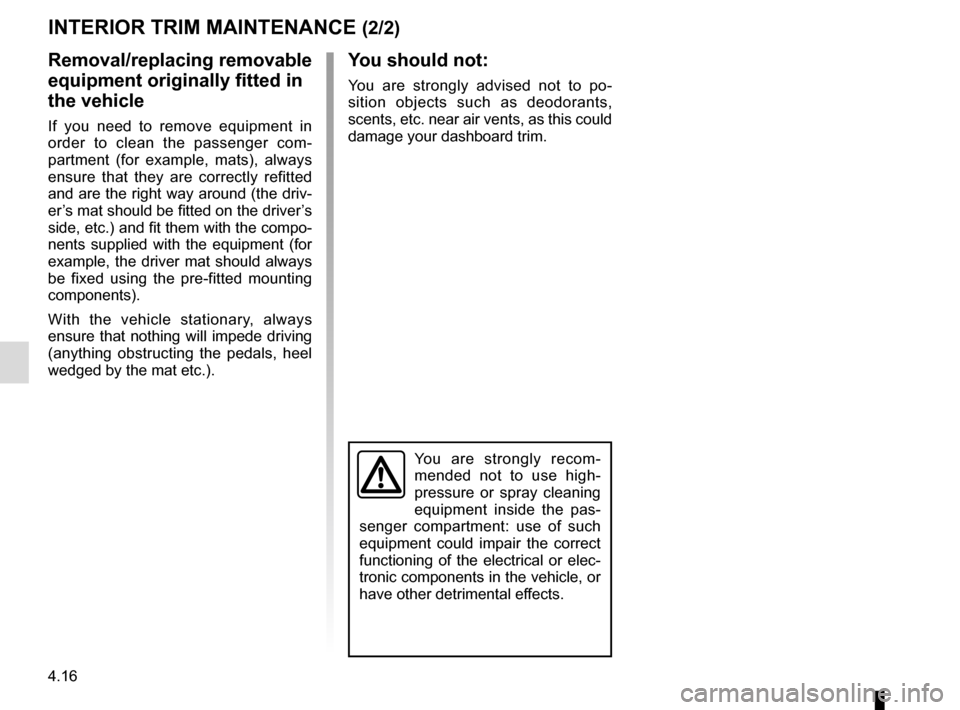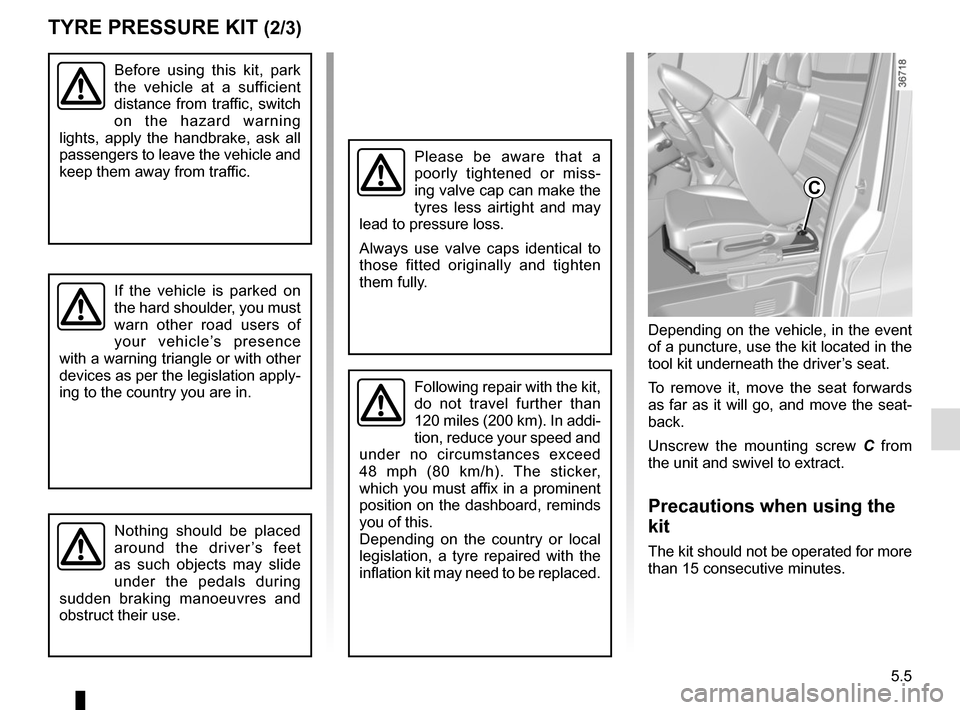2017 RENAULT TRAFIC dashboard
[x] Cancel search: dashboardPage 173 of 294

3.9
Clear View function
Press button 3 – the integrated indica-
tor light comes on.
This function quickly demists and de-
ices the windscreen, the rear screen,
the front side windows, and the door
mirrors (depending on the vehicle). The
air conditioning and rear screen de-ic-
ing functions must be activated.
Press button 8 to stop the heated rear
screen operating, and the integrated in-
dicator goes out.
To exit this function, press button 3
or 1.
AUTOMATIC CLIMATE CONTROL (2/4)
ØThe air flow is distributed be-
tween all the air vents, the
front side window demisting air vents
and the windscreen demisting vents.
½The air flow is mainly directed
to the dashboard air vents.
¿The air flow is directed mainly
towards the footwells.
Adjusting the distribution
of air in the passenger
compartment
Press one of the buttons 4 . The in-
tegrated warning light in the button
comes on.
It is possible to combine two positions
simultaneously – press both buttons 4.
8
3
Some buttons have an operating
tell-tale which indicates the operat-
ing status.
14
Page 187 of 294

3.23
Dashboard passenger
storage compartment 15
To open, press the control 14.
PASSENGER COMPARTMENT STORAGE/FITTINGS (4/9)
Dashboard storage
compartment 10, 11 and 13
Location 12
This location can be used as a cup
holder, a storage compartment or as a
receptacle to fit the ashtray.
Passenger side glove box
To open, press control 16.
Depending on the vehicle, the glove
box may have ventilation and air condi-
tioning (one 1.5 litre bottle can be
stored there).
Nothing should be placed
on the floor (area in front of
driver) as such objects may
slide under the pedal during
braking manoeuvres, thus obstruc-
ting its use.
16
Ensure that no hard, heavy
or pointed objects are
placed in the “open” sto-
rage compartments in such
a way that they may fall onto pas-
sengers during sudden turning, bra-
king or in the event of an accident.
1011
12
13
15
14
Page 222 of 294

4.16
You are strongly recom-
mended not to use high-
pressure or spray cleaning
equipment inside the pas-
senger compartment: use of such
equipment could impair the correct
functioning of the electrical or elec-
tronic components in the vehicle, or
have other detrimental effects.
INTERIOR TRIM MAINTENANCE (2/2)
You should not:
You are strongly advised not to po-
sition objects such as deodorants,
scents, etc. near air vents, as this could
damage your dashboard trim.
Removal/replacing removable
equipment originally fitted in
the vehicle
If you need to remove equipment in
order to clean the passenger com-
partment (for example, mats), always
ensure that they are correctly refitted
and are the right way around (the driv-
er’s mat should be fitted on the driver’s
side, etc.) and fit them with the compo-
nents supplied with the equipment (for
example, the driver mat should always
be fixed using the pre-fitted mounting
components).
With the vehicle stationary, always
ensure that nothing will impede driving
(anything obstructing the pedals, heel
wedged by the mat etc.).
Page 227 of 294

5.5
TYRE PRESSURE KIT (2/3)
Before using this kit, park
the vehicle at a sufficient
distance from traffic, switch
on the hazard warning
lights, apply the handbrake, ask all
passengers to leave the vehicle and
keep them away from traffic.
Nothing should be placed
around the driver’s feet
as such objects may slide
under the pedals during
sudden braking manoeuvres and
obstruct their use.
Please be aware that a
poorly tightened or miss-
ing valve cap can make the
tyres less airtight and may
lead to pressure loss.
Always use valve caps identical to
those fitted originally and tighten
them fully.
If the vehicle is parked on
the hard shoulder, you must
warn other road users of
your vehicle’s presence
with a warning triangle or with other
devices as per the legislation apply-
ing to the country you are in.
Following repair with the kit,
do not travel further than
120 miles (200 km). In addi-
tion, reduce your speed and
under no circumstances exceed
48 mph (80 km/h). The sticker,
which you must affix in a prominent
position on the dashboard, reminds
you of this.
Depending on the country or local
legislation, a tyre repaired with the
inflation kit may need to be replaced.
Depending on the vehicle, in the event
of a puncture, use the kit located in the
tool kit underneath the driver’s seat.
To remove it, move the seat forwards
as far as it will go, and move the seat-
back.
Unscrew the mounting screw C from
the unit and swivel to extract.
Precautions when using the
kit
The kit should not be operated for more
than 15 consecutive minutes.
C
Page 228 of 294

5.6
With the engine running and the
parking brake applied,
– unroll the hose from the container;
– connect the compressor hose 3 to
the container’s inlet 8;
– depending on the vehicle, connect the container 8 to the compressor
from the container recess 7;
– unscrew the valve cap on the rel- evant wheel and screw on the con-
tainer’s inflation adapter 1;
45
1
TYRE PRESSURE KIT (3/3)
Once the tyre is correctly inflated,
remove the kit: slowly unscrew the in-
flation adapter 1 to prevent any repair
product from escaping and store the
container in plastic packaging to pre-
vent the product from escaping.
– Affix the driving recommendation label to the dashboard where it can
easily be seen by the driver;
– Store the kit in the toolkit and re- insert it properly under the driver’s
seat.
– At the end of this initial inflation op- eration, air will still escape from the
tyre. You must drive a short distance
in order to seal the hole.
– Start immediately and drive at be- tween 12 and 40 mph (20 and
60 km/h) in order to distribute the
product evenly in the tyre and, after
driving for 2 miles (3 km), stop and
check the pressure.
– If the pressure is greater than 1.3 bar but less than the recommended
pressure (refer to the label affixed to
the edge of the driver’s door), read-
just it. Otherwise, please contact an
authorised dealer: the tyre cannot be
repaired.
8
– disconnect any accessories previ-ously connected to the vehicle’s ac-
cessories sockets;
– adapter 2 must be connected to the
vehicle accessories socket;
– press switch 4 to inflate the tyre to
the recommended pressure (please
refer to the information on “Tyre infla-
tion pressure” in Section 4);
– after a maximum of 15 minutes, stop inflating and read the pressure (on
pressure gauge 5).
Note: while the container is empty-
ing (approximately 30 seconds), the
pressure gauge 5 will briefly indicate
a pressure of up to 6 bar. The pres-
sure will then drop.
– adjust the pressure: to increase it, continue inflation with the kit; to
reduce it, press button 6.
If a minimum pressure of 1.8 bar is
not reached after 15 minutes, repair
is not possible; do not drive the ve-
hicle but contact an approved dealer.
2
3
7
6
Page 287 of 294

7.1
ALPHABETICAL INDEX (1/5)
A
ABS ..............................................................1.86, 2.21 → 2.25
accessories........................................................................\
5.30
accessories socket ................................................. 3.29 – 3.30
AdBlue ............................................................... 1.116 → 1.119
AdBlue additive.................................................. 1.116 → 1.119
additional methods of restraint .......................................... 1.43 side protection ............................................................. 1.42
to the front seat belts .......................................1.37 → 1.40
to the rear seat belts .................................................... 1.41
additive (tank) .................................................... 1.116 → 1.119
additive tank ...................................................... 1.116 → 1.119
adjusting your driving position ..1.28 – 1.30, 1.32 → 1.36, 3.31
advice on antipollution ....................................................... 2.16
air bag.......................................1.37 → 1.40, 1.42 – 1.43, 1.84
activating the front passenger air bags ........................ 1.79
deactivating the front passenger air bags .................... 1.77
air conditioning ........................................................3.4 → 3.14
air vents ...................................................................... 3.2 – 3.3
anti-corrosion check ..............................................6.18 → 6.22
anti-corrosion protection .................................................... 4.13
anti-lock braking system: ABS ...............................2.21 → 2.25
antipollution advice .................................................................\
......... 2.16
armrest: front ..................................................................\
............ 3.24
ashtray .................................................................... 3.29 – 3.30
audible and visual signals................................................ 1.109
B
battery............................................................ 4.12, 5.24 – 5.25 troubleshooting ................................................. 5.24 – 5.25
bonnet........................................................................\
. 4.2 – 4.3
brake fluid ........................................................................\
.... 4.8
bulbs changing ..........................................................5.14 → 5.21C
catalytic converter.............................................................. 2.10
central door locking 1.4 → 1.6, 1.13, 1.16 → 1.21, 1.23 → 1.27
changing a bulb .....................................................5.14 → 5.21
changing a wheel...................................................... 5.9 – 5.10
changing gear .................................................................... 2.11
child restraint/seat ....................1.44 – 1.45, 1.47 → 1.64, 1.77
child safety......1.15, 1.40, 1.44 – 1.45, 1.47 → 1.64, 1.77, 2.4,
3.15 – 3.16
child seats..........................................1.44 – 1.45, 1.47 → 1.64
children ................................. 1.2, 1.7, 1.44 – 1.45, 3.15 – 3.16
children (safety) ................................................... 1.2, 1.7, 1.15
cigar lighter ............................................................. 3.29 – 3.30
cleaning: inside the vehicle .............................................. 4.15 – 4.16
clock ..................................................................... 1.99 – 1.100
closing the doors ........................................... 1.14 – 1.15, 1.27
control instruments ..........................1.84 → 1.91, 1.99 – 1.100
controls ...............................................................\
...1.80 → 1.83
courtesy light ................................................. 3.18 – 3.19, 5.20
cruise control ................................................1.87, 2.29 → 2.32
cruise control-speed limiter....................................2.26 → 2.32
D
dashboard..............................................................1.80 → 1.83
deadlocking the doors ................................................ 1.6, 1.13
demisting rear screen ......................................................... 3.8 → 3.11
windscreen .................................................. 3.5, 3.8 → 3.11
dimensions .............................................................\
...6.4 → 6.7
dipstick................................................................\
................. 4.4
display ................................................................\
...1.84 →
1.89
doors......................................................................1.18 →
1.21
doors/tailgate .......................1.2 → 1.8, 1.13, 1.23 – 1.24, 1.27
driver’s position .....................................................1.80 → 1.87
driving ............ 2.2 → 2.6, 2.10, 2.14, 2.18 → 2.33, 2.35 – 2.36